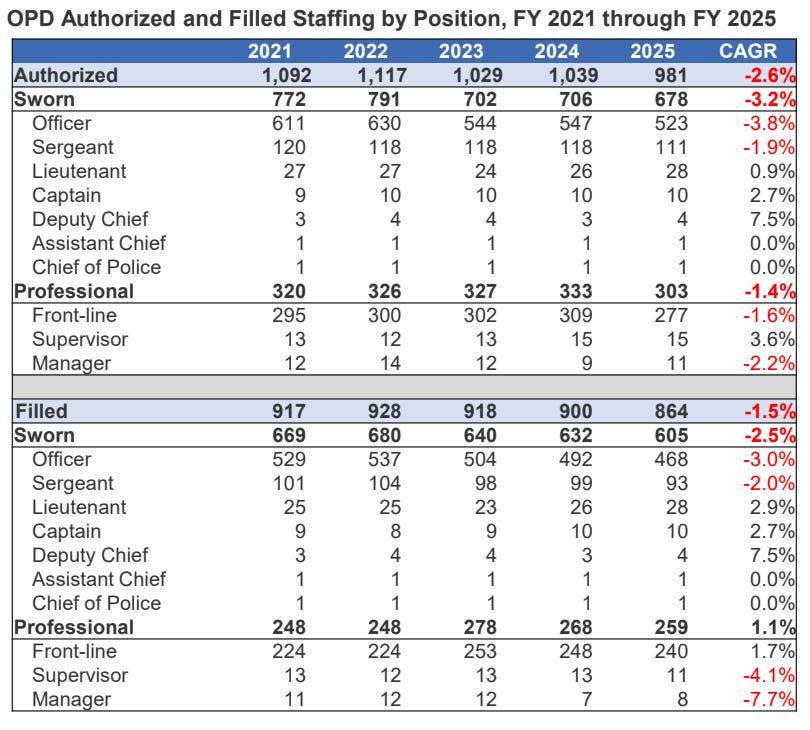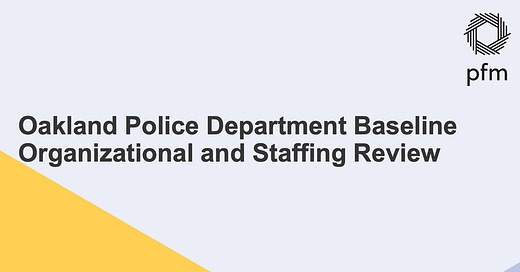Oakland releases police staffing study—it says a minimum of 877 officers are needed
After denying a public records request, the city reversed course and released the full report
Last week, we reported that the City of Oakland denied our public records request for the Oakland Police Department (OPD) staffing study. The study was commissioned by the city council in 2023 and performed by PFM, an external contractor, in 2024. The city claimed exemption from the California Public Records Act—suggesting it was not in the public interest to disclose the report.
Now, the city has reversed course. It released the full report (241 slides) from PFM. No explanation was provided for the reversal.
Here are its key findings.
Baseline staffing needs
OPD needs a baseline of 877 sworn officers. That is 277 more than are currently authorized, and 199 more than were authorized at the time of the study. This is estimate is based on OPD’s workload in 2022, the last year for which adequate operational data were available.
70% of the estimated gap in sworn officers was in the Bureaus of Field Operations (patrols) and 30% was in the Bureau of Investigations (crime investigations).
The staffing estimate was based on analysis of calls for service, staffing schedules, time spent on call-response, training, leave, vacation, proactive policing, and administrative time. The study relied on police logs, schedules, documents and interviews. It did not perform a detailed time and effort observational study of police officers executing their daily work tasks.
An estimate of the baseline of professional staff (non-sworn) was out of scope for the study, and was not provided.
Current OPD staffing
Current authorized OPD staffing fell 19% since 2021 to 885 (600 sworn officers plus 285 civilian staff).
885 is the number authorized in the contingency budget enacted in December 2024). The report assumed 981 authorized positions at OPD — that higher number reflects the original budget in effect at the time of the study.

Allocation of officers’ time
An officer’s time breaks down as: 80% on shifts (42 weeks per year); 3 to 5% on training (2-3 weeks per year); and 16% on vacation, illness, and leave (8 weeks per year).
Of an officer’s 10-12 hour shifts, 60% is spent responding to calls for service (about 6 hours), 10% on proactive policing (about 1 hour), 20% on administrative tasks (about 2 hours), 10% on breaks (about 1 hour).
The department’s target for proactive policing time is 30-40%, which was co-developed with City leaders, OPD, and Oakland residents. The actual time spent on proactive policing ranged from 3 to 35%, across patrol areas, with an average of about 10%.
Proactive policing is a set of tasks intended to prevent and reduce crime and disorder, rather than simply reacting to calls for service about crime and disorder. Examples:
Increasing non-crime related interactions with the community.
Hot spot proactive policing.
Preventive patrol to deter crime.
Use of Force policy / NSA — impact on officer workload
The implementation of a new Type 32 policy in 2022 resulted in a significant increase in the number of use of force reports. Type 32 force is considered the lowest level category of force (Level 4). In 2021, 681 Level 4 incidents were recorded. In 2022, there were 4,442, due to this new reporting requirement.
This additional workload is prioritized due to the requirements of the Negotiated Settlement Agreement (NSA). This requirements include that all uses of force, including the drawing or pointing of a firearm, must be thoroughly documented and reviewed by supervisors.
Several OPD personnel expressed concern that the Type 32 policy was too burdensome and could inhibit officers from taking necessary enforcement action(s) because of the administrative report requirements.
Training Division supervisors are routinely assigned to Division Level Inquiries (DLIs) that overflow from other parts of the agency. Many of these DLIs are for minor use of force incidents. Similarly, a sergeant in the Research and Planning Division is also routinely assigned overflow DLI cases.
The assignment of DLIs to the Training Division can detract from the Training Division's core mission of facilitating and managing departmental in-service and providing police academy instruction.
Investigations
105 crime investigators are needed, which is almost double the 58 budgeted in FY2025.
The Bureau of Investigations lacks a centralized case management system. Overall, there is little supervisory infrastructure for case assignment or case management in the bureau, with investigators largely self-assigning cases.
Benchmarking analyses
Oakland was benchmarked against seven similar-sized cities, considering population, demographics, crime rates, and consent decree status.
In 2023, Oakland had a higher total property crime rate and ranked third in total violent crime among the benchmark cities. (See prior Oakland Report analysis concluding the same.)
Oakland had a higher rate of violent and property crimes per sworn and professional staff compared to the benchmark median. For example, Oakland's total violent crime per sworn staff was 11.1 compared to the benchmark median of 5.2.
OPD's clearance rates for both violent and property crimes were very low relative to the benchmark cities. For property crimes, OPD's average clearance rate was 0.5%, compared to the benchmark median of 7.3%. For violent crimes, OPD's average clearance rate from 2019-2023 was 9.8%, compared to the benchmark median of 29.9%.
Overtime
When professional positions are frozen due to budget deficits, those unfilled functions often become the responsibility of sworn officers, which reduces available officer time for patrol and other duties, and reduces efficient deployment of staff, and increases demand for overtime hours.
For example, the Communications Division within the Bureau of Services has faced staffing shortages, resulting in extensive use of mandatory overtime.
Increasing staffing in patrol and investigations could potentially reduce the workload on patrol officers responding to calls, allowing for more efficient handling of incidents and potentially reducing the need for overtime related to call response.
Costs
Police officers and management (governed by the OPOA and OPMA collective bargaining agreements) received a 10% raise in the past 3 years, while civilian professional staff (governed by SEIU and IFTPE collective bargaining agreements) received a 14% raise over the past 3 years.1
Budget for personnel costs (salaries, benefits, and overtime) grew 1% since FY2020 budget. Budget for non-personnel costs (services, vehicles, equipment and supplies) grew 3% over the same time. The total budget grew from $350M to $368M.
Tags: Police, Policing, City Council, Budget
Four different bargaining units represent the majority of OPD employees:
Oakland Police Officers Association (OPOA) – 68.6%. Included: Police Officer Trainee, Police Officer, Sergeant, and Lieutenant.
Oakland Police Management Association (OPMA) – 1.6%. Included Captain, Deputy Chief
International Federation of Professional & Technical Engineers Local #21 (IFPTE) – 17.6%. Included: Communications Dispatchers, analyst positions, and professional supervisors and managers
Service Employees International Union Local #1021 (SEIU) – 12.1%. Included: Police Services Technicians, Evidence Technicians, Records Specialist, and administrative roles.






Thanks again, Mr. Gardner. I suspect this report would never have been released without your reporting last week. Really daunting, unsurprising, critical information.
They waited until after yesterday’s election.